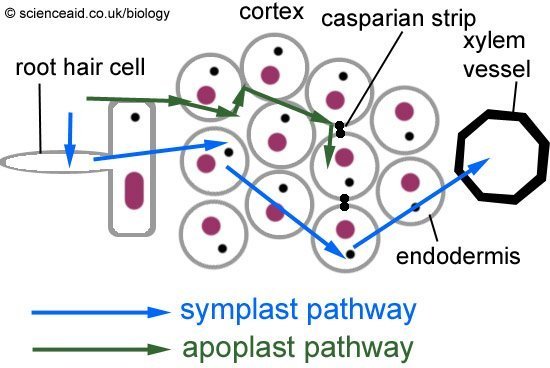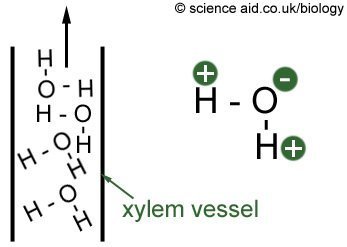Water in Plants
Edited by Jamie (ScienceAid Editor), Taylor (ScienceAid Editor)
How Water Enters
NB Plant cells are not round, but are represented as such in the diagram because it makes the diagram simpler.
The diagram shows how water enters into a plant from the roots and eventually to the xylem vessel which transports water.
- 1The first method is the symplast pathway. As the diagram shows, here water travels from cell to cell, being moved by a water potential until it eventually enters the xylem, which moves water away and maintains the water potential.Symplast Pathway.Advertisement
- 2The second method that is most common, accounting for 90% of water movement is the apoplast [ap-oh-plar-st] pathway. This is when the water travels through gaps in the cell wall without having to cross any cell membranes, however, this route is stopped at the endodermis by the casparian strip which is waterproof that seals the cell wall and forces the water to enter the cells and complete its journey by the symplast.Apoplast Pathway.
Transpiration
Something that concerns Botanists is whether water is pushed or pulled from the roots to the leaves. If it was pushed from the root, then water would spurt out of a cut branch. There is, however, a degree of root pressure to move water up the plant. But most of the force to move it up the plant is done by pulling, and is explained by the cohesion-tension hypothesis.
Water is very special because it is a permanent dipole, if you are not a chemist, this means that there are two hydrogen atoms, and one oxygen atom (H2O) bonded, as shown above, to make one molecule of water. However, the bonds are not shared evenly, and the oxygen (O) pulls a little harder than the hydrogens (H) which means that O becomes slightly negatively charged and the H positive. As you know, opposites attract and this means that the negative and positive bits of the molecules stick together. This sticking together is called 'cohesion. It happens in the xylem vessel - it is shown on the left in the diagram.
All of these molecules make a string all the way up the vessel, which terminates at the leaves, and at the stomata, where water is lost. When a molecule is lost, it pulls on this string of water which moves it up. And the loss of water from the leaves is known as transpiration'. And there are a few factors that influence its rate. Outlined in the table.
| Factor | Rate... | Explanation |
|---|---|---|
| Temperature | Increases | When it is warmer, the water molecules move around more which means that they're more likely to leave. |
| Humidity | Decreases | When it is humid, there is a lot of water in the atmosphere, so the concentrations between the leaf and air are similar and there is less diffusion. |
| Wind | Increases | This is an obvious one. When it is windy, the water is blown from the stomata. |
| Light | Increases | The light causes the stomata to open because more photosynthesis will be able to happen, so more water is able to leave. |
Xerophytes
A xerophyte is a plant that is adapted to live in very dry conditions, like a desert, for example. There are a number of different adaptations that a plant may have to enable it to survive, these include...
| Adaptation | How it works |
|---|---|
| Leaves reduced to spines | Cacti have many spines which are their version of leaves. Spines have a smaller surface area which means less water is lost. |
| Thick cuticle | The cuticle is the waxy layer that covers plants. Having a thicker one makes it more impermeable which means water cannot leave very easily. |
| Leaf rolled inwards | Grasses do this. They bend over so that all the stomata face each other. This means that moist air is trapped near the surface and it reduces water loss by diffusion. |
| Hairs | This adaptation uses the same principle as above, but it uses hairs to trap a layer of water near the stomata. |
Referencing this Article
If you need to reference this article in your work, you can copy-paste the following depending on your required format:
APA (American Psychological Association)
Water in Plants. (2017). In ScienceAid. Retrieved Apr 25, 2024, from https://scienceaid.net/biology/plants/waterplants.html
MLA (Modern Language Association) "Water in Plants." ScienceAid, scienceaid.net/biology/plants/waterplants.html Accessed 25 Apr 2024.
Chicago / Turabian ScienceAid.net. "Water in Plants." Accessed Apr 25, 2024. https://scienceaid.net/biology/plants/waterplants.html.
If you have problems with any of the steps in this article, please ask a question for more help, or post in the comments section below.
Comments
Article Info
Categories : Plants
Recent edits by: Jamie (ScienceAid Editor)










